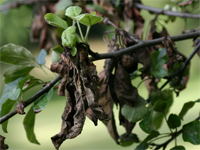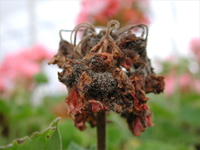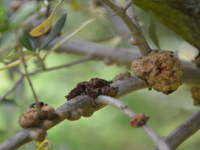Team:Nevada/project/background
From 2013.igem.org
| Line 15: | Line 15: | ||
==Three Diseases, Three Endolysins== | ==Three Diseases, Three Endolysins== | ||
[[File:Erwinia.png|right]]The first pathogen we chose to focus on was ''Erwinia amylovora'', which is a very harmful gram negative bacterium that causes fire blight in apple and pear trees (Billing, 2011). Despite the fact that ''Erwinia'' was the first bacterial plant pathogen to be identified in the late 1790’s, fire blight still remains one of the most devastating diseases to target pome fruits. The bacteriophage ERA103 is known to attack ''Erwinia amylovora''. The bacteriophage endolysin, Lyz103, uses a signal anchor release (SAR) mechanism to degrade the peptidoglycan layer of the bacterial cell wall (Kuty et al., 2010) (Kuty, 2013). | [[File:Erwinia.png|right]]The first pathogen we chose to focus on was ''Erwinia amylovora'', which is a very harmful gram negative bacterium that causes fire blight in apple and pear trees (Billing, 2011). Despite the fact that ''Erwinia'' was the first bacterial plant pathogen to be identified in the late 1790’s, fire blight still remains one of the most devastating diseases to target pome fruits. The bacteriophage ERA103 is known to attack ''Erwinia amylovora''. The bacteriophage endolysin, Lyz103, uses a signal anchor release (SAR) mechanism to degrade the peptidoglycan layer of the bacterial cell wall (Kuty et al., 2010) (Kuty, 2013). | ||
| - | |||
| - | |||
[[File:Xanth.png|right]]The second pathogen we choose to focus on was ''Xanthomonas Campestris pathovar pelargonii'', which causes a serious disease called bacterial blight in geraniums. The bacteria forms water-soaked lesions on leaves and travels through the vascular tissue, causing stem necrosis and death (Strider, 1985). In order to target this disease, we chose a putative endolysin from ''Xanthomonas'' bacteriophage Xp15 from UniProt Protein Knowledgebase, which predicted the role of this protein based on genome sequencing. | [[File:Xanth.png|right]]The second pathogen we choose to focus on was ''Xanthomonas Campestris pathovar pelargonii'', which causes a serious disease called bacterial blight in geraniums. The bacteria forms water-soaked lesions on leaves and travels through the vascular tissue, causing stem necrosis and death (Strider, 1985). In order to target this disease, we chose a putative endolysin from ''Xanthomonas'' bacteriophage Xp15 from UniProt Protein Knowledgebase, which predicted the role of this protein based on genome sequencing. | ||
Revision as of 01:24, 28 September 2013


Endolysins as a Novel Approach to Pest Control
Pest control is an issue that is dealt with all over the globe (Irving, 1970). Despite our best efforts to control infections and other parasites that affect our agriculture, nature has found a way to try to outrun our solutions and treatments (Loessner, 2005b). Current treatments for the many kinds of bacterial pathogens that attack crops are imperfect, ineffective, potentially harmful to the environment, and sometimes just non-existent (Okabe and Goto, 1963) (Segner and Scholthof, 2007). There is a need for a new, smarter approach to pest control.
One example of a current treatment is the use of copper on Erwinia amylovora. This treatment has many disadvantages but is still one of the more commonly used methods to treat this bacterium. In addition to the copper treatment's many environmental harms, research has shown that Erwinia amylovora is finding ways to develop a resistance to the treatments or hide in a state of latency when regulated with copper (Ordax et al., 2006).
Even bacteriophage technology, which has already been approved for use in food preparation and agriculture, can sometimes cause resistance, which is why phage cocktails such as AgriPhage must be continuously tested and updated. There are also still concerns about releasing a mutating, self-replicating virus into the environment to treat plants.
This year’s Nevada iGEM team proposed the potential of endolysin proteins to be used as a bactericide. Endolysins are proteins that come from bacteriophages and are responsible for host cell lysis. They function with varying mechanisms, but, like bacteriophages, they are each highly specific to their target strain of bacteria and do not harm surrounding flora and fauna. There are also implications that these endolysins do not trigger a resistance response in bacteria(Schmelcher et al., 2012). This makes endolysin therapy an exciting alternative to all current treatment methods.
We chose three endolysins to fight three gram negative bacteria that infect common crops.
Three Diseases, Three Endolysins
The first pathogen we chose to focus on was Erwinia amylovora, which is a very harmful gram negative bacterium that causes fire blight in apple and pear trees (Billing, 2011). Despite the fact that Erwinia was the first bacterial plant pathogen to be identified in the late 1790’s, fire blight still remains one of the most devastating diseases to target pome fruits. The bacteriophage ERA103 is known to attack Erwinia amylovora. The bacteriophage endolysin, Lyz103, uses a signal anchor release (SAR) mechanism to degrade the peptidoglycan layer of the bacterial cell wall (Kuty et al., 2010) (Kuty, 2013). The second pathogen we choose to focus on was Xanthomonas Campestris pathovar pelargonii, which causes a serious disease called bacterial blight in geraniums. The bacteria forms water-soaked lesions on leaves and travels through the vascular tissue, causing stem necrosis and death (Strider, 1985). In order to target this disease, we chose a putative endolysin from Xanthomonas bacteriophage Xp15 from UniProt Protein Knowledgebase, which predicted the role of this protein based on genome sequencing.
 "
"


